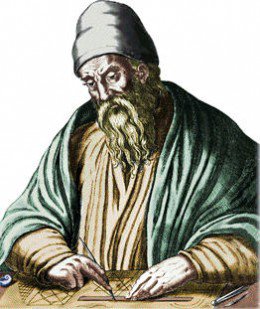Euclides and the scientific birth of mathematics.

The mathematics that we know today was preceded by a practical-empirical period, and reached its theoretical maturity of generalization and axiomatization with Euclid, who takes it to the scientific context towards the year 300 before Christ, with the birth of Euclidean geometry.
In the structure of Euclid's geometry, a set of definitions, postulates and propositions are presented. In the definitions, Euclid used two types of concepts, which he called implicit definitions and explicit definitions.
For Euclid's implicit definitions, they had no definition. On the other hand, the explicit ones, to which he properly considered definitions, defined them as: point, straight, plane.
After the definitions, the postulates came, these, for Euclid were self-evident truths. So he developed five postulates in his geometry.
They are as follows:
Any two points determine a line segment.
A line segment can extend indefinitely in a straight line.
You can trace a circle given a center and any radius.
All right angles are equal to each other.
Postulate of the parallels.
Finally, when the postulates are combined, the theorems are deduced (to which Euclides called propositions).
At the moment an axiomatic similar to the system of the Euclidian postulates exists, but assuming a new denomination. What Euclides called definitions, are called concepts. It is then spoken of primitive or undefined concepts, which are the implicit definitions of Euclid. The defined concepts correspond to the explicit definitions; to the postulates are called axioms and propositions, theorems.
The axiomatic structure is the same, only the rules of deduction are missing, which are the same laws of formal logic, today called rules of operation. Theorems are the objects of the demonstration, proceed from the most immediate to give rise to new theorems.
This process led to the classical intuitive positions, such as Pythagoras's Theorem, to arrive at elemental axiomatization through the Elements of Euclid, then contemporaneously with modern formalization through the formalization of Hilbert in 1900.
And this formalization of mathematics passes through logic. The elements of the logical expression S is P are replaced by F (x), or x = y, and the syllogism is replaced by the derivation rule. Thus, mathematical theory is transformed into a set of symbols, a language, that serves to know a certain region of objects of the real world.
Source:
Núñez Tenorio, J. R. Introduction to Science. Panapo Caracas. 2006.
https://es.wikipedia.org/wiki/Postulados_de_Euclides
Image taken from Google, tagged for reuse.
Oh no, I hate math!
I do not think you hate her so much. I bet you liked it sometime.
Oh nice, thanks for sharing, I love reading about the history of science, you should check out my blog @tolulope.tolu
Now following you, please reciprocate!
Thanks for reading me. Greetings. Of course I will review your blog.
Do you mind checking your references? The wikipedia page is marked as non existing for me. Thanks in advance for your consideration!
Thank you for your request. I already corrected the reference. Greetings.
it's working now, thanks
thanks